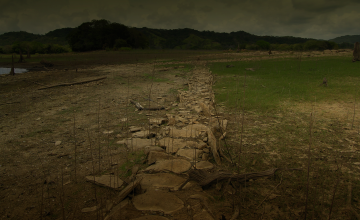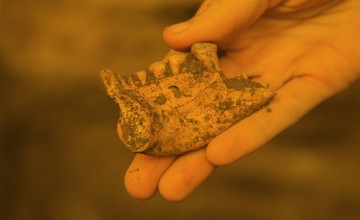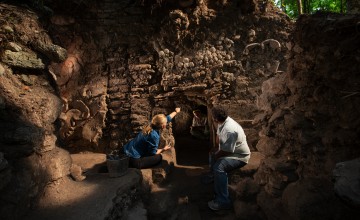
Ashley
Sharpe
Humans have held a precarious position on this planet, intentionally and unintentionally modifying it for millennia. To understand the world today we must look back in time and trace our role in the ongoing process of environmental change on local and global scales.
Projects and Stories
Recent Publications
Mobility and lead isotopes, 2017
Contemporary Challenges in Zooarchaeological Specimen Identification, 2017
Research Focus
Research in my lab examines the long and complex history of peoples and cultures in the Americas, and how these ancient societies developed both by changing, and being transformed by, their surrounding environment. My lab uses zooarchaeology, or the identification of animal bones, shells, and other faunal materials from archaeological excavations, in combination with stable isotope analysis to address the many questions concerning how humans made use of animals in the past, such as for food and as craft items, for fostering and maintaining status distinctions, for exchange and tribute relations, and for ritual performances and as symbols.
Additional links
Contact
Research Overview
What effect have humans had on tropical environments over the last several thousand years?
We often take for granted how unnatural our present-day landscape actually is. The Neotropics are no exception, having been occupied by untold numbers of humans for thousands of years. These societies permanently altered plant and animal populations through hunting and harvesting, by domesticating new species, moving and introducing species into new areas, and by occasionally harming or exterminating certain taxa, especially in recent years. To understand the tropical landscape today and what is “natural,” we need to examine and be able to recognize where and how humans have influenced the environment in the past.
How were animals integral to the rise of ancient communities and early states?
Animals and their resources were used for much more than just food in ancient societies, just as they are today. Hunting, fishing, raising and exchanging animals has happened for centuries, profoundly changing both the course of human societies as well as the spread and evolution of animal species on the landscape. As human populations grew over time, people made increasing efforts to control and selectively distribute certain animals and their products, which helped develop and maintain complex political and economic state systems.
How did ancient pre-Columbian societies manage and move animal resources?
Ancient peoples in the Americas were often on the move, and so were their animals. Dogs, turkeys, macaws, fish, and shellfish are only a few of the animals we know that were moving frequently throughout Central America as part of an extensive trade network. Moving and raising animals necessitated specialized experience and knowledge of how to acquire, maintain, and breed particular species. Using zooarchaeological analysis in combination with stable isotope geochemistry, we can study how animals were hunted or bred (often resulting in dramatic changes to their skeletal development), were raised in captivity and fed a human-mandated diet, and were exchanged long distances from one area to another.
Education
2016 Ph.D., Anthropology, University of Florida. Dissertation: A Zooarchaeological Perspective on the Formation of Maya States.
2011 M.A., Anthropology, University of Florida Master’s Thesis: Beyond Capitals and Kings: A Comparison of Animal Resource Use among Ten Late Classic Maya Sites.
2009 B.A., Archaeology, Minor in Biology, Magna cum Laude, Boston University Senior Honors Thesis: From Ritual to Rubbish: The Maya Zooarchaeological Record from San Bartolo, El Petén, Guatemala.
Selected Publications
Sharpe, Ashley E., Juan Manuel Palomo, Takeshi Inomata, Daniela Triadan, Flory Pinzón, Jason Curtis, Kitty Emery, George Kamenov, John Krigbaum, Jessica MacLellan, and María Paula Weihmüller. 2024. An isotopic examination of Maya Preclassic and Classic animal and human diets at Ceibal, Guatemala. Journal of Archaeological Science: Reports 55:104522. https://doi.org/10.1016/j.jasrep.2024.104522
Sharpe, Ashley E. and John Krigbaum, editors. 2022. Isotope Research in Zooarchaeology: Methods, Applications, and Advances. University Press of Florida, Gainesville. ISBN 13: 9780813069418.
Sharpe, Ashley E., Bárbara Arroyo, Lori E. Wright, Gloria Ajú, Javier Estrada, George D. Kamenov, Emanuel Serech, and Emily Zavodny. 2022. Comparison of human and faunal enamel isotopes reveals diverse paleodiet and exchange patterns at the highland Maya Site of Kaminaljuyu, Guatemala. Archaeological and Anthropological Sciences 14(1):1-17. https://doi.org/10.1007/s12520-021-01498-8
Sharpe, Ashley E., Nicole Smith-Guzmán, Jason Curtis, Ilean Isaza-Aizpurúa, George D. Kamenov, Thomas A. Wake, and Richard G. Cooke. 2021. A Preliminary Multi-isotope Assessment of Human Mobility and Diet in Pre-Columbian Panama. Journal of Archaeological Science: Reports 36:102876. https://doi.org/10.1016/j.jasrep.2021.102876
Sharpe, Ashley E., Takeshi Inomata, Daniela Triadan, Melissa Burham, Jessica MacLellan, Jessica Munson, and Flory Pinzón. 2020. The Maya Preclassic to Classic Transition Observed through Faunal Trends from Ceibal, Guatemala. PLOS ONE 15(4):e0230892. https://doi.org/10.1371/journal.pone.0230892
Sharpe, Ashley E., Kitty F. Emery, Takeshi Inomata, Daniela Triadan, George D. Kamenov, and John Krigbaum. 2018. Earliest Isotopic Evidence in the Maya Region for Animal Management and Long-Distance Trade at the Site of Ceibal, Guatemala. Proceedings of the National Academy of Sciences. https://doi.org/10.1073/pnas.1713880115


